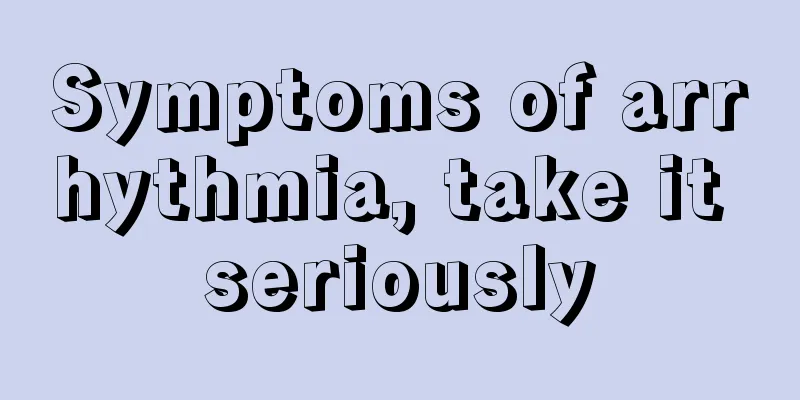Symptoms of arrhythmia, take it seriously

|
Arrhythmia is an important group of cardiovascular diseases. It may cause many other breast diseases. It can occur alone or in conjunction with other cardiovascular diseases. But its initial symptoms are not very obvious, and we must pay close attention to it in our daily lives, especially the middle-aged and elderly people. Otherwise it may lead to heart failure or even sudden death. Clinical manifestations The clinical manifestations of hemodynamic changes of arrhythmia mainly depend on the nature, type, cardiac function and degree of influence on hemodynamics of the arrhythmia. For example, mild sinus bradycardia, sinus arrhythmia, occasional premature atrial contraction, first-degree atrioventricular block, etc. have little effect on hemodynamics, so there is no obvious clinical manifestation. More serious arrhythmias, such as sick sinus syndrome, rapid atrial fibrillation, paroxysmal supraventricular tachycardia, sustained ventricular tachycardia, etc., can cause palpitations, chest tightness, dizziness, hypotension, sweating, and in severe cases, syncope, Adams-Stokes syndrome, and even sudden death may occur. Due to the different types of arrhythmias, the clinical manifestations vary, mainly including the following manifestations: 1. Symptoms of coronary artery insufficiency Various arrhythmias can cause a decrease in coronary blood flow. Although various arrhythmias can cause a decrease in coronary blood flow, they rarely cause myocardial ischemia. However, for patients with coronary heart disease, various arrhythmias can induce or aggravate myocardial ischemia, which is mainly manifested as angina pectoris, shortness of breath, peripheral vascular failure, acute heart failure, acute myocardial infarction, etc. 2. Symptoms of cerebral artery insufficiency Different arrhythmias have different effects on cerebral blood flow. For those with normal cerebrovascular diseases, the above-mentioned hemodynamic disorders will not cause serious consequences. However, if cerebrovascular diseases occur, they will be enough to cause insufficient blood supply to the brain, which will manifest as dizziness, fatigue, blurred vision, temporary blindness, and even transient or permanent brain damage such as aphasia, paralysis, convulsions, and coma. 3. Symptoms of renal artery insufficiency After arrhythmia occurs, renal blood flow also decreases to varying degrees, with clinical manifestations including oliguria, proteinuria, azotemia, etc. 4. Manifestations of mesenteric artery insufficiency When rapid arrhythmia occurs, blood flow decreases and mesenteric artery spasms, which can produce clinical manifestations of gastrointestinal ischemia such as abdominal distension, abdominal pain, diarrhea, and even bleeding, ulcers, or paralysis. 5. Symptoms of heart failure The main symptoms are cough, difficulty breathing, fatigue, weakness, etc. |
<<: Tooth endodontic root canal treatment helps relieve
>>: Can patients with brain glioma be cured?
Recommend
The difference between fried coix seed and raw coix seed Fried coix seed, raw coix seed, difference
Many people have eaten fried and raw coix seeds i...
The real effect of Angelica Aloe Capsules turns out to be like this
Angelica Aloe Capsules are named after aloe becau...
What not to eat when you have acne on your face
Acne on the face is a common phenomenon. When man...
Effective treatment for intestinal tumors
Intestinal tumor is an anorectal disease caused b...
What are the characteristics and treatment of sebaceous cysts?
Cortical cysts can occur in many parts of the bod...
6 DIY ways to turn your home into an allergy-free oasis
Fortunately, with a few simple ideas and a small ...
What is abdominal breathing
Many people have heard of abdominal breathing, es...
What is the cause of primary sclerosing cholangitis
It is important to understand the cause of primar...
What are the early symptoms of colon cancer
At present, colon cancer is a type of cancer with...
The best treatment for chronic urticaria
People who have not experienced chronic urticaria...
Onychomycosis survival time
"If you have onychomycosis, one person can i...
What effect does drinking water have on physical examination
There will be a routine physical examination befo...
Special prescription for stopping bleeding in urine caused by bladder cancer
Special prescription for stopping bleeding in uri...
How to prevent hair loss?
Many people have symptoms of hair loss, especiall...
How to eat calendula and the effects of calendula toner
Calendula is a plant that has magical effects on ...









